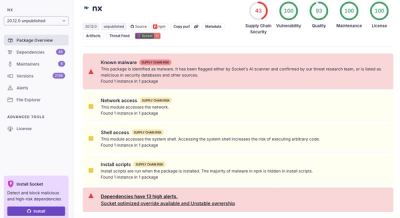
Security News
/Research
Wallet-Draining npm Package Impersonates Nodemailer to Hijack Crypto Transactions
Malicious npm package impersonates Nodemailer and drains wallets by hijacking crypto transactions across multiple blockchains.
@googlemaps/react-wrapper
Advanced tools
React component that wraps the loading of Google Maps JavaScript API.
[!IMPORTANT]
This library has been archived. We recommend all users of this package to switch to the new@vis.gl/react-google-maps, which provides a collection of components and hooks and can be configured to be fully compatible with this package.See the migration guide for more details on how to switch from this package to
@vis.gl/react-google-maps.
Wrap React components with this library to load the Google Maps JavaScript API.
import {Wrapper} from '@googlemaps/react-wrapper';
const MyApp = () => (
<Wrapper apiKey={'YOUR_API_KEY'}>
<MyMapComponent />
</Wrapper>
);
The preceding example will not render any elements unless the Google Maps JavaScript API is successfully loaded. To handle error cases and the time until load is complete, it is recommended to provide render props.
import {Wrapper, Status} from '@googlemaps/react-wrapper';
const render = status => {
switch (status) {
case Status.LOADING:
return <Spinner />;
case Status.FAILURE:
return <ErrorComponent />;
case Status.SUCCESS:
return <MyMapComponent />;
}
};
const MyApp = () => <Wrapper apiKey={'YOUR_API_KEY'} render={render} />;
When combining children and render props, the children will render on success and the render prop will be executed for other status values.
import {Wrapper, Status} from '@googlemaps/react-wrapper';
const render = (status: Status): ReactElement => {
if (status === Status.FAILURE) return <ErrorComponent />;
return <Spinner />;
};
const MyApp = () => (
<Wrapper apiKey={'YOUR_API_KEY'} render={render}>
<MyMapComponent />
</Wrapper>
);
This wrapper uses @googlemaps/js-api-loader to load the Google Maps JavaScript API. This library uses a singleton pattern and will not attempt to load the library more than once. All options accepted by @googlemaps/js-api-loader are also accepted as props to the wrapper component.
The following snippets demonstrates the usage of useRef and useEffect hooks with Google Maps.
function MyMapComponent({
center,
zoom,
}: {
center: google.maps.LatLngLiteral;
zoom: number;
}) {
const ref = useRef<HTMLDivElement>();
const [map, setMap] = useState<google.maps.Map | null>(null);
useEffect(() => {
const map = new google.maps.Map(ref.current, {center, zoom});
setMap(map);
return () => {
google.maps.event.clearInstanceListeners(map);
setMap(null);
};
}, []);
useEffect(() => {
if (!map) return;
// do something with the map instance
}, [map]);
return <div ref={ref} id="map" />;
}
See the examples folder for additional usage patterns.
Available via npm as the package @googlemaps/react-wrapper.
npm i @googlemaps/react-wrapper
or
yarn add @googlemaps/react-wrapper
For TypeScript support additionally install type definitions.
npm i -D @types/google.maps
or
yarn add -D @types/google.maps
The reference documentation can be found at this link.
This library is community supported. We're comfortable enough with the stability and features of the library that we want you to build real production applications on it.
If you find a bug, or have a feature suggestion, please log an issue. If you'd like to contribute, please read How to Contribute.
FAQs
React component that wraps the loading of Google Maps JavaScript API.
We found that @googlemaps/react-wrapper demonstrated a healthy version release cadence and project activity because the last version was released less than a year ago. It has 4 open source maintainers collaborating on the project.
Did you know?

Socket for GitHub automatically highlights issues in each pull request and monitors the health of all your open source dependencies. Discover the contents of your packages and block harmful activity before you install or update your dependencies.

Security News
/Research
Malicious npm package impersonates Nodemailer and drains wallets by hijacking crypto transactions across multiple blockchains.

Security News
This episode explores the hard problem of reachability analysis, from static analysis limits to handling dynamic languages and massive dependency trees.

Security News
/Research
Malicious Nx npm versions stole secrets and wallet info using AI CLI tools; Socket’s AI scanner detected the supply chain attack and flagged the malware.